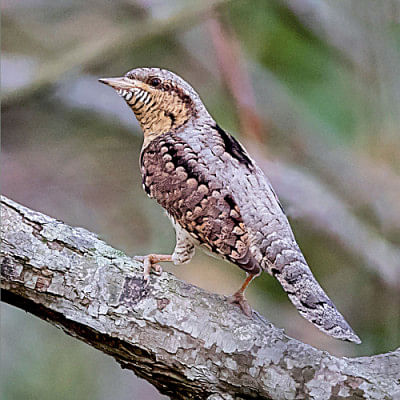Eurasian Wryneck

There are over two hundred species of woodpeckers in the world. The vast majority of these are grouped as "true woodpeckers" with similar features and behaviours. There are, however, two other groups in the woodpecker family: the strange-looking Wrynecks and the diminutive Piculets.
Wrynecks are similar to true woodpeckers in that they have a large head and long tongues to probe inside cavities. They also have the zygodactyl feet of true woodpeckers: first and fourth toe pointing backward and the second and third pointing forward. However, Wrynecks are smaller than true woodpeckers, about the size of a large sparrow, with shorter bills. Lacking the stiff tail feathers of true woodpeckers they cannot climb up or down tree trunks tapping for cavities. Thus they are found mostly on the ground or at lower branches where they look for ants, their main diet.
There are two species of Wrynecks in the world. The Eurasian Wryneck, or Jinx torquilla, can be found in Europe and Asia. In Bangladesh it is a migratory bird in autumn and winter found in villages and fields. The name "torquilla" comes from the Latin "torquere", to twist, in recognition of the bird's ability to turn and twist its head in all directions. Its Bangla name, gharbetha, translates to "pain in the neck."
The second Wryneck, called The Red-throated Wryneck or Jinx ruficolis, is found in sub-Saharan Africa.
I saw my first Eurasian Wryneck in Purbachol five years ago on a late winter afternoon. I was walking northwards and had crossed two villages with nothing to show for it. On the way from the second to the third village there was a banana grove to my left. I saw something small inside the grove, hopping and skipping from place to place, staying low. It did not seem particularly shy so I was able to photograph it. Later, when I looked at the photographs, I was struck by the unusual patterns on its feathers. It looked like snakeskin.
Over the next few years, I saw several more Eurasian Wrynecks in Purbachol and the forests of Sylhet. They were almost always close to the ground, alone, and more shy than the first one I saw. Most recently I saw one in mid-September in a grove of creekside dhoncha plants in Purbachol. It gave me a few seconds to photograph before flying off.
With a global population of fifteen million and a wide geographical range, the Eurasian Wryneck is not considered an endangered species. However, it is a bird worth seeking for its strange plumage and unusual head movements.
www.facebook.com/ikabirphotographs or follow "ihtishamkabir" on Instagram.

 For all latest news, follow The Daily Star's Google News channel.
For all latest news, follow The Daily Star's Google News channel. 



Comments